A Rock Road and a Brick Oval
Prev
Next


|
Day 3: September 22, 2012 A Rock Road and a Brick Oval |
Prev Next |
 
|
|
|
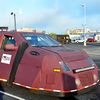 When I first spotted this vehicle in Denny's parking lot this morning, I thought it
might be the monster that appeared in the IMAX film Tornado Alley.
It isn't (It's from TornadoVideos.net.) but it solved a problem for me. I
wanted to write about a couple of things from Friday night but I had no
pictures to go along with the words. One was a movie premier and one was
the drive through rain and hail to get to it. The armored tornado chaser
is the perfect "wish I'd been driving this" vehicle.
When I first spotted this vehicle in Denny's parking lot this morning, I thought it
might be the monster that appeared in the IMAX film Tornado Alley.
It isn't (It's from TornadoVideos.net.) but it solved a problem for me. I
wanted to write about a couple of things from Friday night but I had no
pictures to go along with the words. One was a movie premier and one was
the drive through rain and hail to get to it. The armored tornado chaser
is the perfect "wish I'd been driving this" vehicle.
The movie was being shown about a dozen miles straight down the road from my hotel. A light drizzle was just beginning as I set out. It soon became a steady rain which became a heavy rain. Then there was a little hail mixed in then a little more. The rain became a deluge and the hail started to sound like golf balls being dropped on the car's roof from a great height. It didn't take long for that downpour to create foot deep streams in the outer lanes of the road. As the streams got deeper and the hail got louder, it suddenly got darker. It was already dark but now the street lights went out. I never encountered non-working traffic signals and all lighting appeared to be working as I approached my destination but at least a couple miles of my drive was without the benefit of overhead lighting. I began the first day of this trip lamenting that I was prevented from driving my old -- and leaky -- convertible Valiant. As hail pounded the roof and rooster tails shot high above it, my mind was saying, "Thank you driveway sealer man. Thank you." The movie I was off to see was produced by members of Historic Roads whose conference, "Preserving the Historic Road 2012", was also being held in Indianapolis. The Why in the Road uses Indiana roads and people to address the question "Why are these roads so important to preserve?" This is not a slick Hollywood production but neither is it crude and amateurish. The video is quite good; The audio less so. The audio isn't all that bad but music and interviews sometimes start or end abruptly and sound levels vary. No words are lost and it is certainly listenable but it is evidence that the movie is not, as I've already said, a slick Hollywood production. The movie does not provide a single crystal clear answer to the question it asks but it offers many suggestions. I don't know what plans are for the movie. Though not perfect it is still very good and something every road fan I know would enjoy and its potential for making others aware that historic roads do exist is obvious. Hopefully it becomes generally available in some form. |
|
|
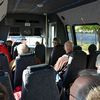
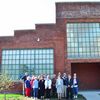
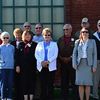 Saturday morning's bus tour was titled "The Indiana Automotive
Pioneers Tour" and included drive-bys of more that twenty homes and
factories connected with automobile manufacturing in Indianapolis. At one
point in the early twentieth century, Indianapolis was second only to Detroit,
Michigan, in number of automobile manufacturers. We did stop at the former
Duesenberg plant specifically for a group photo. Since the location was
significant and we had made an effort to be there, I included the not
exactly readable Duesenberg ghost sign in a picture. Then, because it is
always nice the actually see individuals in a group picture I did a
tighter framed version, too.
Saturday morning's bus tour was titled "The Indiana Automotive
Pioneers Tour" and included drive-bys of more that twenty homes and
factories connected with automobile manufacturing in Indianapolis. At one
point in the early twentieth century, Indianapolis was second only to Detroit,
Michigan, in number of automobile manufacturers. We did stop at the former
Duesenberg plant specifically for a group photo. Since the location was
significant and we had made an effort to be there, I included the not
exactly readable Duesenberg ghost sign in a picture. Then, because it is
always nice the actually see individuals in a group picture I did a
tighter framed version, too.
|
|
|
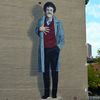 We reached our lunch location a little early so has several minutes to
stroll around the area. Art shops and trendy cafes are plentiful but I'm
neither all that artsy nor particularly trendy. Fortunately I spotted this
tall Kurt Vonnegut (an Indianapolis native) about a block away.
We reached our lunch location a little early so has several minutes to
stroll around the area. Art shops and trendy cafes are plentiful but I'm
neither all that artsy nor particularly trendy. Fortunately I spotted this
tall Kurt Vonnegut (an Indianapolis native) about a block away.
Those who believe in telekinetics, raise my hand, KV. |
|
|

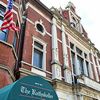
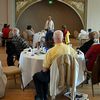
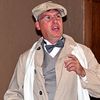
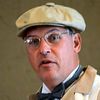 Lunch was at the Athenaeum in downtown Indianapolis.
It was called Das Deutshe Haus in 1912 when Carl Fisher and James Allison hosted a
dinner there and Carl proposed a Coast to Coast Rock Highway. With the help of
Jeff Kuehl, he did it again today. You could sometimes see him looking off
into the future as he talked about the road that would become the Lincoln Highway.
Carl was a dreamer but a very persuasive one. When he turned his attention
our way, I'm pretty sure the guys next to me were ready to pull out their checkbooks.
Lunch was at the Athenaeum in downtown Indianapolis.
It was called Das Deutshe Haus in 1912 when Carl Fisher and James Allison hosted a
dinner there and Carl proposed a Coast to Coast Rock Highway. With the help of
Jeff Kuehl, he did it again today. You could sometimes see him looking off
into the future as he talked about the road that would become the Lincoln Highway.
Carl was a dreamer but a very persuasive one. When he turned his attention
our way, I'm pretty sure the guys next to me were ready to pull out their checkbooks.
|
|
|
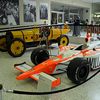
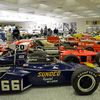
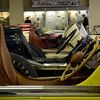
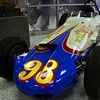
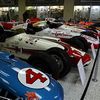
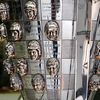 Our afternoon was spent at the
Indianapolis Motor Speedway Museum where my first
focus was personal memories. My Dad listened to the race in the 1950s so I
did, too. I don't recall him rooting for any one in particular and neither
did I -- until 1959. I listened as Rodger Ward led 130 of the 200 laps and
crossed the finish line 23 seconds ahead of Jim Rathmann. As I imagine he
did to a lot of twelve year old males, Ward became my hero that day. The
next year the racing was even better as Jim and Rodger started and ended
one-two and battled furiously in between. This time Rathmann was first
with Ward less than 13 seconds behind him. A.J. Foyt got his first win in
1961 but Ward wasn't far behind in third. Ward won again in 1962 and
followed that with a fourth place in 1963 and a second in 1964. Six years;
Six top fours. It was good to be a Rodger Ward fan. The car from Rodger's
first win isn't in the museum but I found his 1959 face on the Borg-Warner
Trophy. The 1962 #3 car is in the middle of that
line of roadsters in the second picture. The year following Ward's second
win Dad took me and a buddy to watch a day of qualifying. I attended
thirteen consecutive 500s starting in 1981 but prior to that, my only
track visit was that magic day in 1963 when we saw #98 break the 150 MPH
qualifying mark with Parnelli Jones at the wheel. Studebaker, with its new
Avanti, was the pace car that year. Before today, that was the only time
I'd visited the Speedway Museum. It was in a different building then and
much smaller.
Our afternoon was spent at the
Indianapolis Motor Speedway Museum where my first
focus was personal memories. My Dad listened to the race in the 1950s so I
did, too. I don't recall him rooting for any one in particular and neither
did I -- until 1959. I listened as Rodger Ward led 130 of the 200 laps and
crossed the finish line 23 seconds ahead of Jim Rathmann. As I imagine he
did to a lot of twelve year old males, Ward became my hero that day. The
next year the racing was even better as Jim and Rodger started and ended
one-two and battled furiously in between. This time Rathmann was first
with Ward less than 13 seconds behind him. A.J. Foyt got his first win in
1961 but Ward wasn't far behind in third. Ward won again in 1962 and
followed that with a fourth place in 1963 and a second in 1964. Six years;
Six top fours. It was good to be a Rodger Ward fan. The car from Rodger's
first win isn't in the museum but I found his 1959 face on the Borg-Warner
Trophy. The 1962 #3 car is in the middle of that
line of roadsters in the second picture. The year following Ward's second
win Dad took me and a buddy to watch a day of qualifying. I attended
thirteen consecutive 500s starting in 1981 but prior to that, my only
track visit was that magic day in 1963 when we saw #98 break the 150 MPH
qualifying mark with Parnelli Jones at the wheel. Studebaker, with its new
Avanti, was the pace car that year. Before today, that was the only time
I'd visited the Speedway Museum. It was in a different building then and
much smaller.
I've no particular memories connected with the cars in the last three pictures but I kind of liked the pictures. The very last picture shows what a difference a century makes. That's Ray Harroun's 1911 race winning Marmon Wasp on the left and Dan Wheldon's 2011 Dallara/Honda on the right. Aside from the obvious technology advances something else has happened over the century that I don't consider an advance at all. In 1911 there were, by my count, twenty-four different automobile models represented by the forty entrants. That meant it was necessary that I identify the 1911 winner as a Marmon. Identifying the 2011 winner as a Dallara/Honda wasn't necessary at all. Every one of the thirty-three entrants was a Dallara/Honda. The Speedway was conceived as a manufacturer's test track but that aspect of the place slowly faded over the first nine decades. It's now completely gone and the Indianapolis 500 is formula racing presented as pure entertainment. It's sometimes good entertainment but I sure miss the Novis and Chevys and Buicks and Alphas and turbines and diesels and cars with six wheels. |
|
|
| [Prev] [Site Home] [Trip Home] [Contact] [Next] |